The Aesthetics and Functionality of Waterfall Edge Kitchen Islands
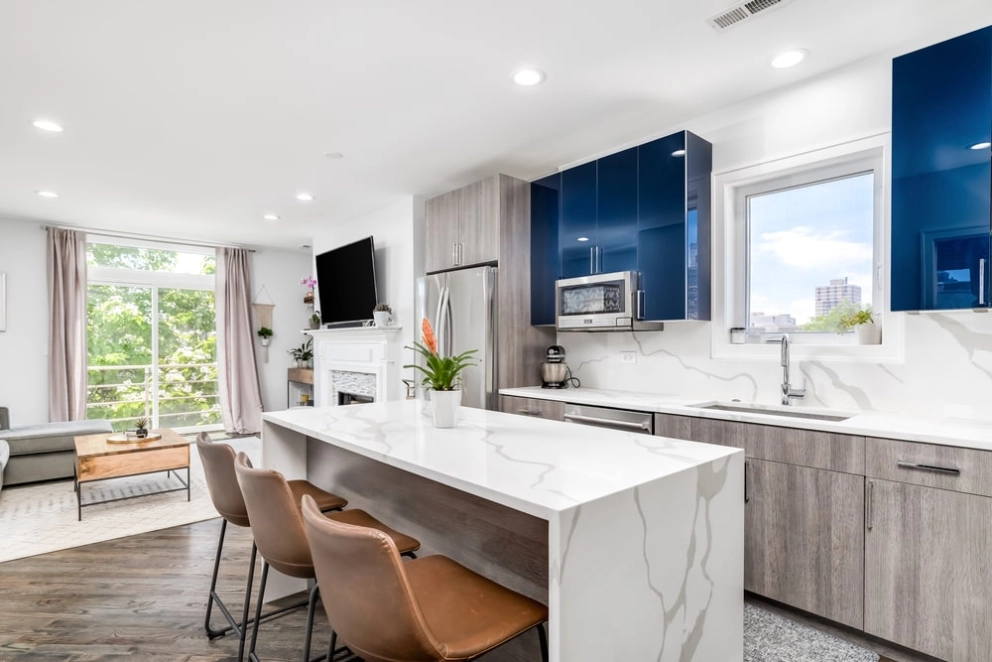
An island adds a ton of extras to a kitchen. This area is meant for sitting, outlining work zones, and providing extra preparation space. With so many benefits, kitchen islands have become desirable units for many homeowners. As a cherry on top, a kitchen island can significantly enhance your interior aesthetic. We’re talking about the waterfall effect of the kitchen island. Lately, there has been a decline in demand for this feature, but it is still quite popular.
A waterfall island in the kitchen is a style of island top that does not end at the edge but drops perpendicularly until it touches a floor. This is usually a mitered edge joint that gives a waterfall island effect. This style can be applied also to peninsulas and base unit countertop side edges. The design of a waterfall countertop island is inherent in modern kitchens but requires a lot of planning to not overwhelm the space.
As a waterfall island countertop is traditionally made from the same material as an island top, it acts as a focal point of the room, with no negotiations. If you wish to highlight any other feature, like the chimney hood, you should reconsider using a waterfall edge. And since it pulls a lot of attention to itself you should think thoroughly before applying.
And while a kitchen island with a waterfall edge sounds simple enough, it can have many variations. At the top of its popularity, the waterfall edge was more of a decorative feature. Now that it is migrating into the ranks of classic kitchen elements, you can see shelves, drawers or appliances added to it. However, no one says that it will be as easy as pie. A kitchen island with a waterfall countertop can present some challenges. And this is a precise reason why you should read this Cut2Size post first.
Types of waterfall countertops for an island
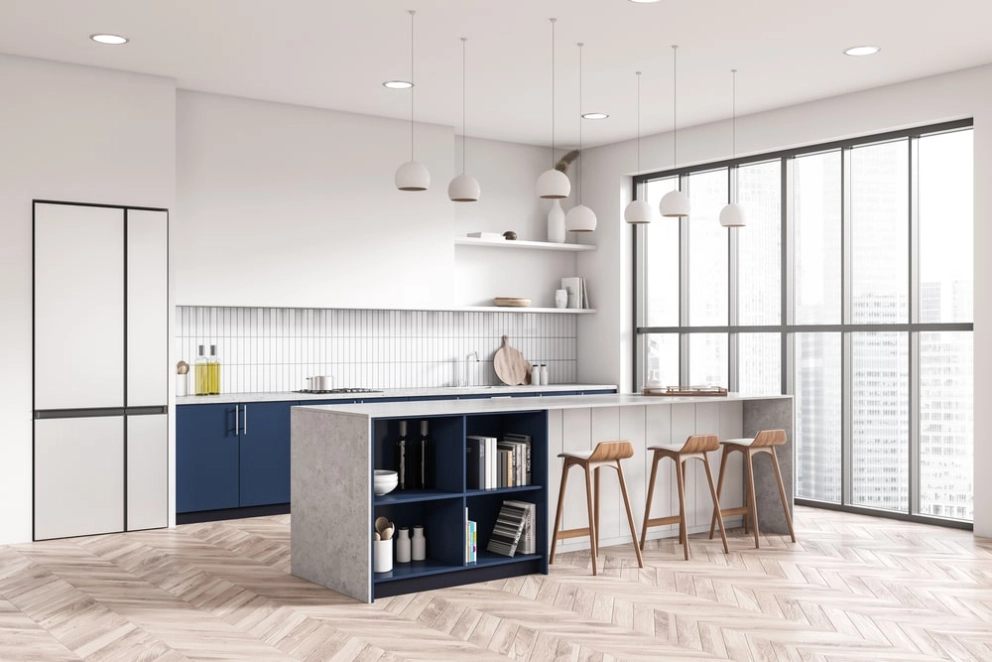
There are different ways to achieve the waterfall effect in your kitchen island countertops. In this section, we will shed light on some of the most ingenious waterfall kitchen island ideas you can do to make your kitchen stand out from the rest.
Large waterfall kitchen island
A double waterfall island is an island that features a waterfall effect on both sides of the kitchen island creating a symmetrical striking look. This double-side waterfall for island effect often involves extending the countertop material down both sides, meeting at the floor. It can make a bold design statement and is often used in larger kitchens or spaces where the island is a central focus.
To achieve a double waterfall effect, ensure precise waterfall island dimensions, measurements, and cuts for the countertop material. Select large-format countertop slabs to minimize seams and create a seamless appearance. Ensure the material's quality and structural integrity can support the size and weight of the island. Professional installation is essential to handle larger and heavier pieces.
One-sided waterfall island
Unlike the double waterfall, a kitchen island waterfall one side features the waterfall effect on just one side of the island. This is usually a small waterfall island that is perfect for compact kitchens. Having a waterfall island on one side offers a sleek and modern look while allowing for seating on the other side.
A kitchen island with a one-side waterfall is perfect for those who want to introduce a modern and stylish element without overwhelming the space. A waterfall island on one side works well in kitchens where the island is positioned against a wall or in open-plan layouts where one side of the island is more visible. Moreover, a waterfall edge on one side of the island allows for a blend of functionality and aesthetics, offering a striking visual statement while leaving the opposite side open for seating, storage, or other functional purposes.
The kitchen island one-side waterfall is also versatile, as it complements various design styles, from contemporary to transitional. A one-side waterfall kitchen island is a great way to incorporate a touch of luxury and sophistication without dominating the entire kitchen space. Additionally, an island with a one-sided waterfall choice can help visually define the kitchen area in open floor plans, creating a distinct boundary without the need for additional walls or barriers.
A waterfall island in the small kitchen is for those who prefer a more subtle design statement. It involves using a smaller piece of countertop material to create the waterfall effect. Despite the smaller size, attention to detail is still crucial when creating a half-waterfall kitchen island. Carefully select the right-sized slab or material to fit the island's dimensions proportionately. A professional can help ensure proper installation.
Waterfall island with overhang
A waterfall island with an overhang on the sides involves extending the countertop material beyond the edge of the island, providing space for seating or creating a bar-like area. Pay attention to the structural support needed for the overhang, especially when considering a waterfall island with seating. Use sturdy materials and proper reinforcement to ensure safety and durability.
A waterfall kitchen island with seating combines the functionality of a seating area with the aesthetic appeal of a waterfall countertop. It often includes an overhang to accommodate stools or a bench. Plan the dimensions of the overhang to comfortably accommodate seating. Ensure the countertop material's durability and consider incorporating support brackets or legs for added stability.
A waterfall kitchen island bench, for example, is ideal for homes where the kitchen serves as a gathering hub, perfect for entertaining guests or accommodating family activities. It's especially advantageous in open-concept layouts, as the island becomes a versatile space for casual dining, homework sessions, or relaxed conversations.
Common materials for kitchen island with waterfall edge
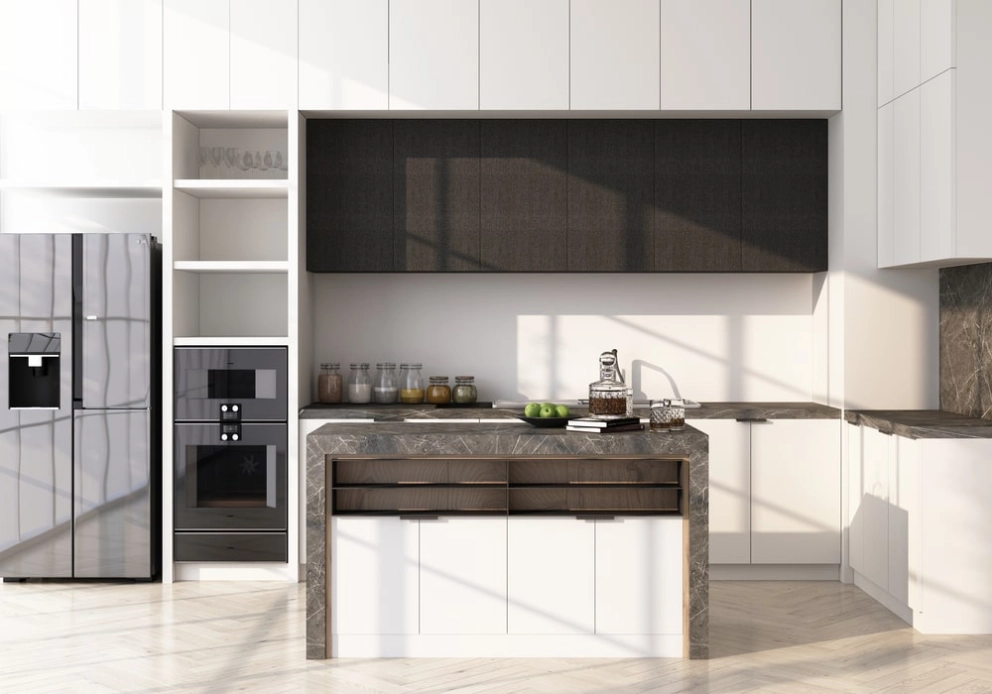
Choosing the right material for an island waterfall countertop is pivotal for both style and practicality. It's essential to weigh factors like durability against daily wear and tear, considering options like granite, quartz, or stainless steel that withstand high traffic and potential spills. Porcelain waterfall island is another alternative for achieving a stone waterfall island effect if you’re looking for a modern way to achieve a stone look without compromising durability. In this section, we will cover the most common stone waterfall kitchen island to help you decide which of these materials suits best for your kitchen.
Waterfall kitchen island from quartz
Waterfall island quartz is a popular choice for kitchen island countertops due to its durability, low maintenance, and versatile aesthetics. Composed of natural quartz crystals and resin, it offers a non-porous surface, making it resistant to stains, scratches, and bacterial growth. Quartz is available in various colours, patterns, and finishes, allowing for a seamless transition in a waterfall design. White quartz waterfall kitchen island, however, is the most popular. A white kitchen waterfall island is a good option if you are into minimalism and contemporary kitchen aesthetics.
Island quartz waterfall is quite heavy, especially in larger slabs used for kitchen islands. Proper structural support is vital to bear the weight of the kitchen island quartz waterfall. Your kitchen's underlying structure may need reinforcement to support your quartz waterfall kitchen island.
The edge profile you choose for your waterfall island kitchen quartz can impact the overall look and may add to the cost. Additionally, the finish of your kitchen island with quartz waterfall (polished, honed, leathered, etc.) can affect its appearance and maintenance requirements.
Proper installation is crucial for the longevity and appearance of your waterfall island. This may involve hiring professionals specializing in quartz countertop installation to ensure it's done correctly.
A waterfall quartz island is an excellent option for those seeking a modern, sleek look with minimal maintenance. Regular cleaning with mild soap and water suffices for maintenance. Opt for an island waterfall quartz if durability, ease of upkeep, and a wide range of design choices are priorities for your kitchen.
Waterfall granite island
Granite waterfall island is renowned for its natural beauty, durability, and heat resistance, making it a classic choice for waterfall islands. Waterfall island granite comes in various colours and unique patterns formed by natural minerals, adding a luxurious touch to the kitchen. While a waterfall granite kitchen island requires sealing to prevent staining, it is highly durable and can withstand heavy use. Maintenance of a granite waterfall kitchen island involves periodic resealing and daily cleaning with a granite-specific cleaner or mild soap and water.
Choosing between a black waterfall island and a white granite waterfall island often depends on various factors, including design preferences, the overall kitchen aesthetic, and practical considerations. A black granite waterfall island offers a striking contrast, particularly in kitchens with lighter tones, exuding a sleek and contemporary feel. Its ability to hide stains can ease maintenance but may make dust or crumbs more visible.
Black granite adds warmth and sophistication, often complementing modern design aesthetics. On the other hand, a white kitchen with a waterfall island creates a bright, airy ambiance, ideal for smaller spaces or kitchens with darker cabinetry, reflecting light to enhance the overall luminosity. It's versatile, adapting well to various decor styles, though it may require more vigilant maintenance to prevent stains or discoloration.
Consider granite for its timeless appeal, durability against heat and scratches, and the opportunity to add natural elegance to your kitchen.
Marble waterfall island
A marble island waterfall exudes elegance and luxury, often featuring distinct veining and patterns that create a sophisticated look in a kitchen. However, a waterfall marble island is more porous and prone to etching and staining from acidic substances, making it high maintenance. Regular sealing and cautious use are necessary to preserve its appearance.
Despite its susceptibility to scratches and stains, marble's aesthetic appeal and unique patterns make it a preferred choice for homeowners seeking a timeless, luxurious look in their kitchens. Choosing a black marble waterfall island, for example, creates contrast in a white kitchen. A black waterfall kitchen island also makes the kitchen space look sophisticated and luxurious – and it is easier to maintain compared to a white marble countertop.
Wood waterfall island

Having a waterfall wood island offers warmth, character, and a natural aesthetic to a kitchen. Butcher block waterfall islands or hardwoods like walnut, cherry, or maple are popular choices for waterfall islands due to their durability and ability to handle food prep. A waterfall island wood, however, requires regular sealing and oiling to maintain its finish and protect against moisture and scratches.
While a wood waterfall kitchen island is generally heat resistant, extreme heat can cause damage, such as scorch marks or burns. Using trivets or hot pads is advisable to protect the surface from direct heat exposure. Keep in mind that different wood species that are used to make waterfall butcher block islands have varying levels of hardness and susceptibility to wear.
For example, hard maple is more resistant to dents and scratches compared to softer woods like pine or fir. Choosing the right wood species can affect the countertop's longevity and durability. Opt for a wooden waterfall island if you desire a cozy, inviting atmosphere, but be mindful of its maintenance needs and vulnerability to scratches and heat.
Concrete waterfall island
A kitchen waterfall island made of concrete is highly customizable, offering various textures, colours, and finishes to suit different design aesthetics. A concrete waterfall edge island is durable, heat-resistant, and can be cast into different shapes and sizes for a personalized look. Sealing a concrete island kitchen waterfall is essential to prevent staining and to maintain its appearance. Concrete is suitable for industrial or modern-style kitchens, offering a unique, customizable appearance and durability that withstands heavy use.
Cost of a waterfall island
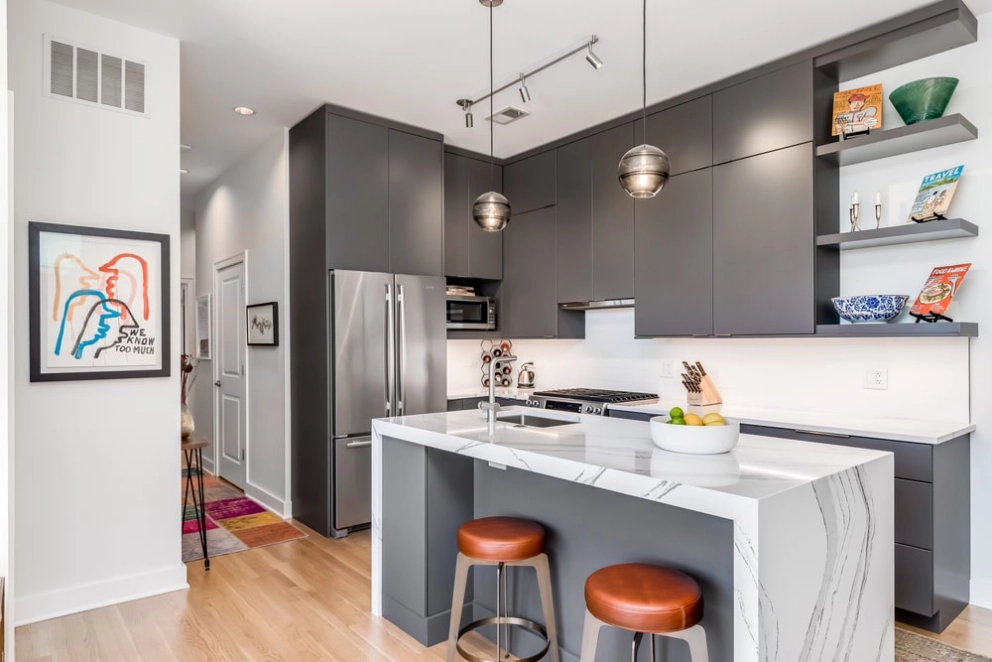
Understanding the waterfall island cost is crucial when planning your kitchen design. While it undoubtedly adds a touch of sophistication and elegance, it's essential to weigh the waterfall countertop island cost against your budget and overall design aspirations. Exploring alternatives, such as using less expensive materials or opting for simpler designs, can help achieve a similar aesthetic while managing costs more effectively.
The waterfall kitchen island price can vary significantly based on several factors. For mid-range to high-end materials and standard sizing, the overall cost can range from $5,000 to $13,000 or more. This wide range accommodates the variability in material costs, labour, installation intricacies, and geographical differences.
A waterfall kitchen island typically carries a higher price tag compared to a common kitchen island. This elevated waterfall island price is primarily attributed to the use of more countertop materials. Knowing the difference between waterfall quartz island costs over marble, wood, and the cost of other materials is essential to achieving your desired kitchen island design within your budget range.
Moreover, the intricate design of a waterfall island demands meticulous craftsmanship, precise alignment of patterns, and specialized labour, all contributing to increased expenses. The installation process for a waterfall island is notably more complex, requiring skilled labour for precise cutting, fitting, and alignment, further amplifying the overall cost.
Waterfall island vs regular island
Still, wondering whether to go for a waterfall island or not? This section might give you a little bit of clarity. An island waterfall edge tends to be more expensive than a normal kitchen island due to the use of premium materials, intricate design, higher labour costs, and more complex installation requirements. Here’s a breakdown of their cost differences.
| Cost factors | Island with a waterfall edge | Regular kitchen island |
| Materials | A kitchen island with a waterfall edge is often made of premium materials like marble, granite, quartzite, or high-end wood which can be pricier due to extended use for the waterfall effect. | Can range from basic to mid-range materials such as laminate, butcher block, or standard granite. |
| Design complexity | More intricate design and fabrication due to the continuous cascading effect of the material down the sides, often requiring specialized labor. | It is typically a simpler design with less intricate craftsmanship required. |
| Labor costs | Higher labour costs due to the precision required for matching and aligning the patterns on all sides. | Relatively lower labour costs as it involves standard construction without intricate detailing. |
| Installation | More complex installation due to precise cutting, fitting, and joining of the cascading material. | Easier installation with fewer precision requirements. |
| Overall cost | Generally, more expensive due to the combination of premium materials and higher labour costs. | Usually less expensive compared to a waterfall island due to the use of simpler materials and less intricate design. |
Potential challenges in design and functionality
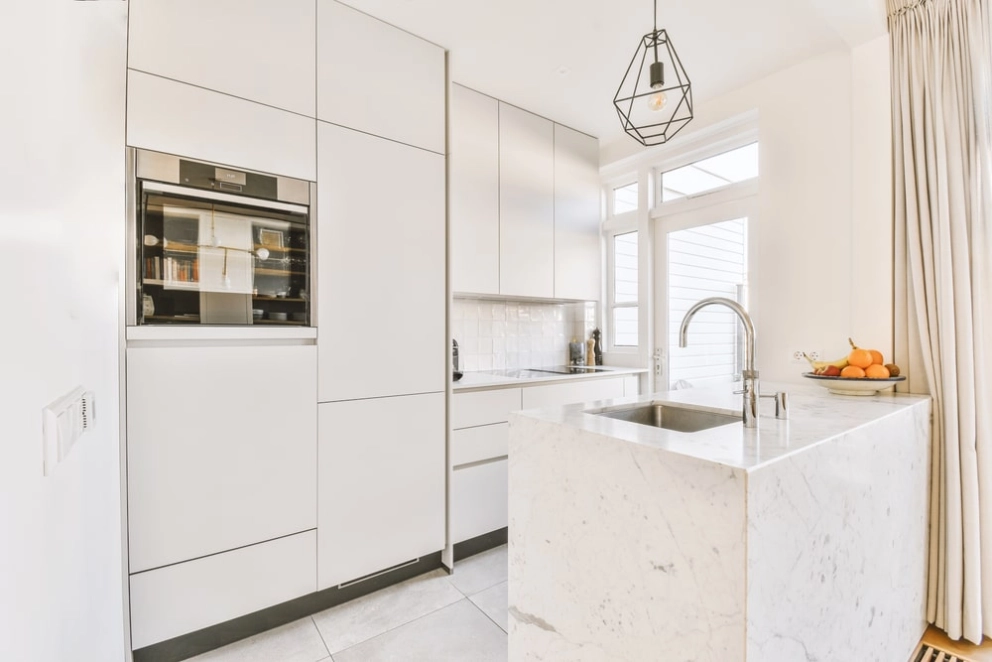
Integrating a waterfall edge into a kitchen island can elevate the aesthetics, but it also presents certain design and functional challenges. These challenges are the following:
- Cost consideration. As discussed earlier, the cost of materials and labour for a waterfall countertop kitchen island is notably higher. This can pose a challenge for those working within a specific budget.
- Maintenance and cleaning. The continuous flow of the material down the sides can create more surface area to clean. Depending on the material used, maintaining and cleaning the vertical surfaces of a waterfall edge might be more challenging compared to a standard island.
- Limited seating options. The waterfall edge can restrict seating options around the island. The cascading sides may limit where stools or chairs can be comfortably placed, affecting the island's functionality as an eating or socializing space.
- Spatial constraints. The design of a waterfall edge might not suit all kitchen layouts. In smaller kitchens or those with limited space, the extension of the countertop material down the sides might visually overwhelm the area, making it feel cramped. Moreover, due to the lack of kickboards with the space for feet, it is uncomfortable to use the end of the island as a worktop.
- Material durability. Depending on the material chosen, the vertical edges of a waterfall island might be more susceptible to damage. For instance, if the material is prone to chipping or scratching, the vertical edge could be more vulnerable in a busy kitchen environment.
- Outlet placement. Incorporating outlets on a waterfall island can pose challenges due to the continuous flow of the material down the sides. A waterfall island with outlets is definitely more efficient and functional but installing outlets in a waterfall island requires careful planning and integration for practical use without disrupting the design. Make sure to consult an expert regarding this to avoid making costly mistakes.
As with any design decision in the kitchen implementing an island with waterfall edges requires thoughtfully exploring your kitchen dimensions and aligning an island with the overall design. Since the waterfall island is going to be the focal point of your kitchen, we recommend planning it following the entire kitchen design. Do not forget to pay attention to convenience (lack of toe kick) and the materials used.


